|
|
|
monthly news from ASAP | NOVEMBER 2022 | asapconnections.org
|
| |
|
|
Registration Is Open for the Business of Farming Conference
|

Registration is open for ASAP's 2023 Business of Farming Conference, taking place Saturday, Feb. 11, at the A-B Tech Conference Center in Asheville. Scholarships for BIPOC and limited-resource farmers are available, as well as discounts for farm partners registering together.
ASAP’s annual Business of Farming Conference brings together professional farmers from across the Southeast region to network and share resources to grow their farm businesses. Farmers learn about marketing, business planning, and financial management from regional experts and innovative peers. The popular lunchtime Grower-Buyer Meeting is a chance to meet with chefs, grocers, and distributors to learn about individual buyer requirements and discuss your products and the potential of a business relationship. The conference is designed for beginning and established farmers as well as those seriously considering farming as a profession.
Interested in sponsorship or exhibitor opportunities? Email [email protected] to find out more.
|
|
 |
Keep Farmers Farming for Another 20 Years
|
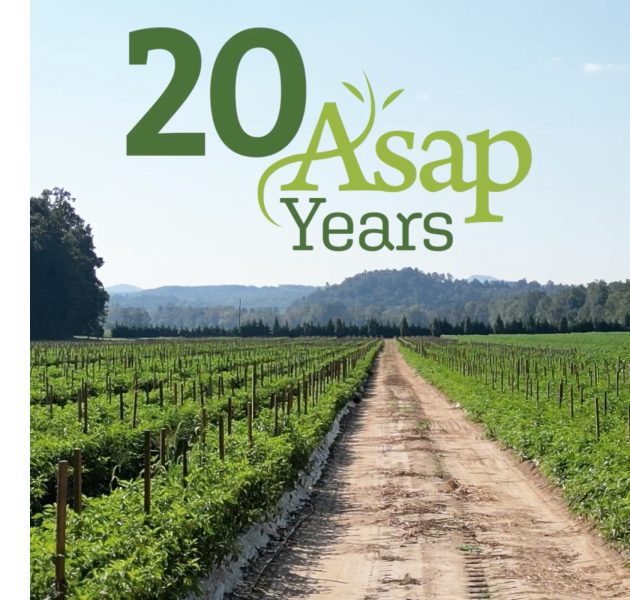 As we close out our celebrations for ASAP’s 20th anniversary year and enter this season of gratitude, we’re reflecting on how our supporters have contributed to the success and longevity of our organization. While this special year is coming to a close, you can help sustain ASAP and the local food movement for another 20 years. Make a plan to include ASAP in Giving Tuesday on November 29! As we close out our celebrations for ASAP’s 20th anniversary year and enter this season of gratitude, we’re reflecting on how our supporters have contributed to the success and longevity of our organization. While this special year is coming to a close, you can help sustain ASAP and the local food movement for another 20 years. Make a plan to include ASAP in Giving Tuesday on November 29!
Giving Tuesday is a part of the holiday season and a way we crowdfund to create the world we wish to live in. Please put a few dollars aside right now so that you can join us in two weeks on this international day of giving to help build a community that reflects your values!
This video reflects on ASAP’s 20 years of local food movement building. As our founder, Charlie Jackson, says, “There were no models for this.” But together, with your support, we figured out how to support small family farms, how to drive demand for local food, and how to support farm to school activities across the region. The local food landscape in WNC looked quite different 20 years ago, and continues to evolve. ASAP is growing with this movement. It takes all of us with a shared commitment to keep farmers farming and build healthy communities!
|
|
 |
New Additions to the Meet Your Farmer Series
|
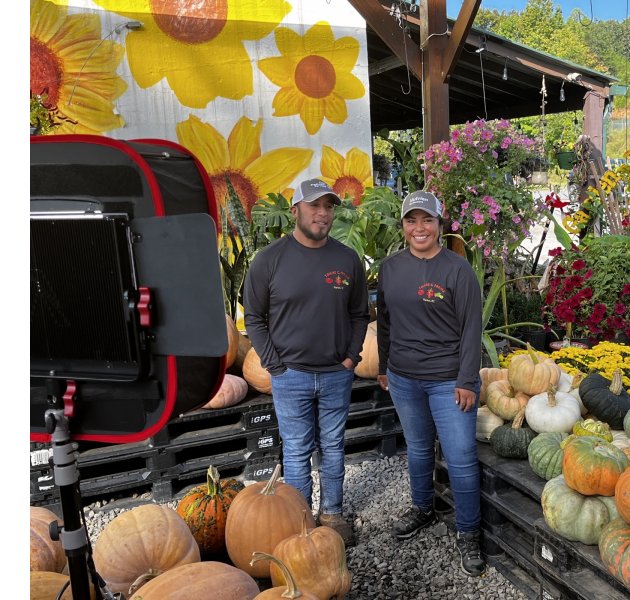 "To be a farmer, you have to learn how to do everything," says Jorge Tomas of Tomas C Farms in Marion, NC. "You have to go out and say, 'okay, I can do this, I can do this better.' There’s a lot of skills. But mostly you have to like being outside." "To be a farmer, you have to learn how to do everything," says Jorge Tomas of Tomas C Farms in Marion, NC. "You have to go out and say, 'okay, I can do this, I can do this better.' There’s a lot of skills. But mostly you have to like being outside."
Three new installments to our Growing Minds Meet Your Farmer series offer insight into farm life throughout Western North Carolina. Meet brother and sister Jorge and Paty Tomas (pictured); the Banks Family from Yellow Mountain Garden in Franklin; and Terry and Debbie Perry of Perry's Berry's Vineyard and Winery in Morganton.
Each video is paired with complementary educational resources, including comprehension questions, lesson plans, and more.
|
|
 |
Farms and Businesses: Get in the Guide
|
 Every year, ASAP calls more than 1,400 businesses to update our Local Food Guide so that we get the most accurate information about connecting with local food and farms. We've started making calls for 2023!
Want to get a head start on updating your listing? You can give us a call (828-236-1282) or do it yourself online (click login in the upper right of appalachiangrown.org). The deadline to be included in the print Local Food Guide is Jan. 31.
Have a new farm, restaurant, retail outlet, or other locally sourcing food business that you want to be listed? Go to appalachiangrown.org and click Get in the Guide. An online listing is completely free.
|
|
 |
Farmers: Look for the Appalachian Grown Producer Survey
|
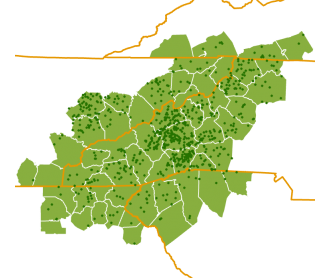 In 2022, there were 831 farms in ASAP's Appalachian Grown network, In 2022, there were 831 farms in ASAP's Appalachian Grown network, which certifies agricultural products grown or raised within 100 miles of Asheville, NC. Every year, ASAP's Local Food Research Center conducts a survey of these farms to learn about their experiences and help shape ASAP's programs.
If you are an Appalachian Grown farm, be on the lookout for the 2023 survey email from Mallory Phillips. Your perspective helps ASAP understand how farming is changing, both in our region and compared to national trends. Additionally, this survey provides ASAP feedback on our work and helps to inform the types of programs and resources that we offer moving forward.
If you have any questions, or if you are an Appalachian Grown farm but have not received the survey, email [email protected]. |
|
 |
 20 YEARS OF ASAP 20 YEARS OF ASAP |
| 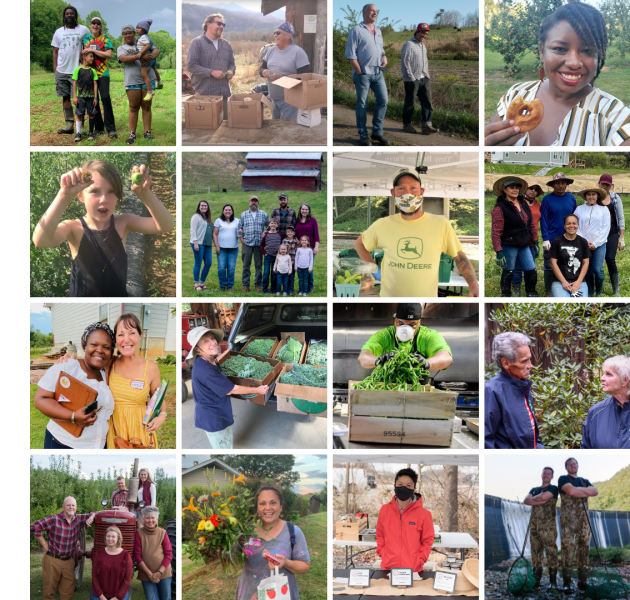 As part of ASAP's 20th anniversary celebration, each month we are sharing the origins of some of our work. This month we're talking about storytelling, a current running through all of ASAP's program areas. As part of ASAP's 20th anniversary celebration, each month we are sharing the origins of some of our work. This month we're talking about storytelling, a current running through all of ASAP's program areas.
Storytelling is a powerful way to connect people to the farms and food in their communities. Firsthand farmer and local food system stories can also be found throughout in ASAP’s print and digital channels, including feature stories in the annual print Local Food Guide, monthly Faces of Local interviews in our newsletter and on our website, and the Growing Minds Meet Your Farmer video series, started in 2020, which takes children (and adults) on virtual farm tours.
Between 2015 and 2021, ASAP produced Growing Local Radio, a weekly segment aired on public radio station WNCW. More than 200 episodes invited listeners onto farms, into school cafeterias and classrooms, into home and professional kitchens, and to farmers markets. These stories (and more!) live on in ASAP's archive of local food stories, searchable by keyword and date. |
|
|
|
 FACES OF LOCAL FACES OF LOCAL |
| | 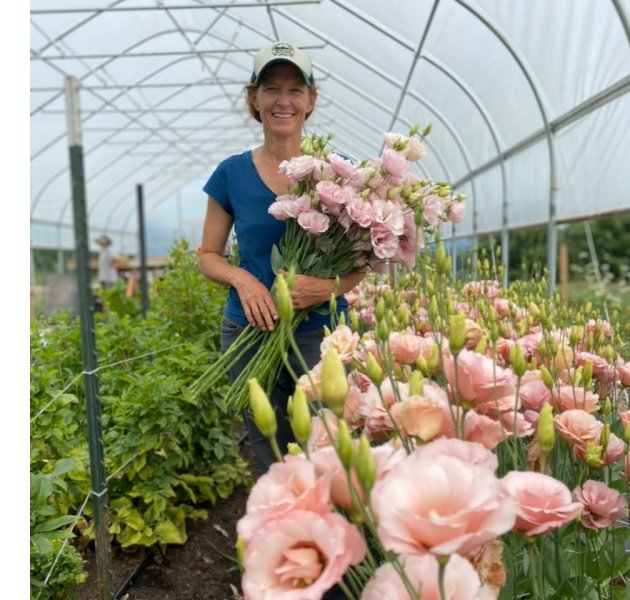 ASAP likes to share the stories of people who help us fulfill our mission. This month we talked to farmer Suzanne Nolter, owner of Blazing Star Flowers, who, like many farmers at this time of year, creates value-added products to sell at holiday farmers markets. Suzanne is selling dried flowers bouquets and wreaths as well as specialty chocolates—studded with herbs and flowers from her farm—at East Asheville Tailgate Market’s final market tomorrow (Friday, Nov. 18) and at River Arts District Farmers Market on Wednesdays through Dec. 21. Her products are available for preorder via blazingstarflowers.com. ASAP likes to share the stories of people who help us fulfill our mission. This month we talked to farmer Suzanne Nolter, owner of Blazing Star Flowers, who, like many farmers at this time of year, creates value-added products to sell at holiday farmers markets. Suzanne is selling dried flowers bouquets and wreaths as well as specialty chocolates—studded with herbs and flowers from her farm—at East Asheville Tailgate Market’s final market tomorrow (Friday, Nov. 18) and at River Arts District Farmers Market on Wednesdays through Dec. 21. Her products are available for preorder via blazingstarflowers.com.
Tell us about Blazing Star Flowers.
We’re currently located at the SAHC Community Farm in Alexander as a participant in the incubator farm program—while also looking to purchase land in WNC for a permanent farm site. We grow over 200 varieties of flowers and botanicals with great care using sustainable, organic, low-till methods on less than an acre. We offer our flowers through our flower CSA (June to September), at farmers markets, and for weddings and special events, including DIY buckets for folks to make their own bouquets. We also create garden-inspired floral designs and host workshops on gardening and design on the farm. In the spring, we provide flower and herb plant starts to grow your own flower gardens.
What have you added for holiday farmers markets through November and December?

I’m selling floral chocolate bars and dried flowers. These value-added products are the culmination of a long-held dream to combine my love of flowers and chocolate! They are celebratory dark chocolate bars, tempered in molds and then garnished with dried edible flowers and herbs from my farm. Some also include organic freeze-dried fruit, such as raspberries. All bars are vegan and gluten free. In December, I’ll start offering boxes of bonbons created with herbal and floral infusions!
I’m also selling dried flowers, as both bouquets and wreathes. These include unique and unusual specialty cut flower varieties and are a wonderful way to brighten up the darker months. When enjoyed indoors, they can easily last until spring and beyond.
You've also worked as a chocolatier as well as in other arts disciplines. What are some of the ways all of those pieces come together for you as a flower farmer?
Before launching Blazing Star Flowers, I worked as a commercial vegetable/fruit/honey farmer, farm educator, chocolatier, artist, and mindfulness retreat center chef. I love the creativity of running my own farm-based business. It allows me to pull in my many passions to make products and experiences that I hope bring joy, connection, and celebration into folks’ daily lives, holidays, and special events. I’m able to draw on my previous work with beautiful, thoughtful food through my floral chocolate work. My fine art experience is used daily in my floral design, crop selections, chocolate work, and teaching floral design workshops.
What keeps you farming?
I enjoy the variation and seasonal cycles of farming and owning a small business. No two days, weeks, months, or years are ever the same! I consider working outside daily with nature a great privilege. Constantly observing, interacting with, and anticipating the weather, creatures, and plants in and around my farm is a fascinating process and continual surprise. Every season is an opportunity to work more skillfully with my crops, soil, and the natural ecosystem. It’s the work of a lifetime and a process that never really ends. Even after growing flowers for many years, there are new discoveries and areas for improvement that are constantly revealed. There is also a meaningful satisfaction in seeing folks light up looking at flowers at market, making a bouquet at a workshop, or how weekly CSA flowers brighten their home or that of a loved one. Sharing this delight and deep meaning with others is what helps pull me through those long, tough days on the farm.
Do you have food or other traditions you turn to during the holiday season?
Since I was a kid, I’d likely be up late on Christmas Eve DIYing my own gifts: sewing lavender pouches, baking biscotti, making soap, or block printing cards. I still enjoying making gifts for loved ones, but as I’ve gotten older I get them done at a more civilized hour (usually…).
Two favorite family holiday dishes are pureed rutabagas (straight up, no cream, salt, pepper, or butter) and stuffing (a Pennsylvania Dutch family recipe with lots of fresh herbs, potatoes, and butter, and baked so it gets delicious crunchy edges).
You can find many specialty or gift items from farmers and other makers at holiday farmers markets around the region. Find a schedule of markets near you.
|
|
|
|
 RECIPE OF THE MONTH RECIPE OF THE MONTH |
|
Chef Kelsianne Bebout's Spiced Apple Pie
|
| 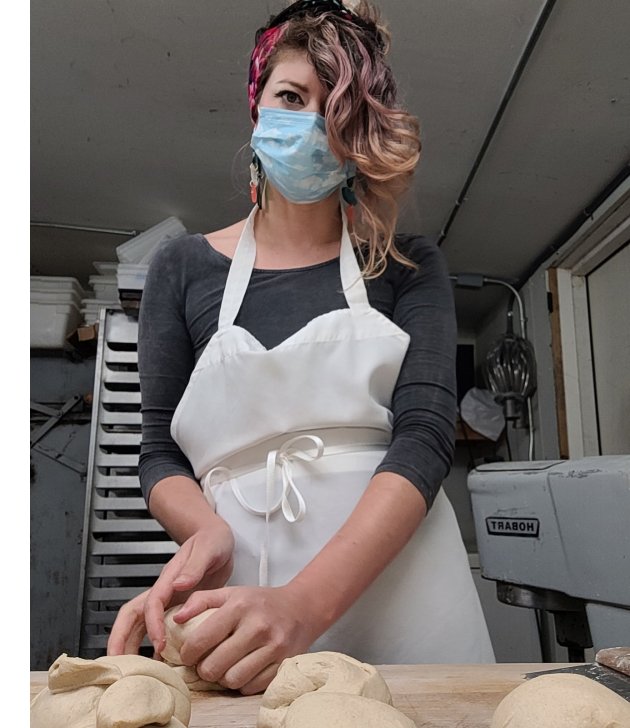 Are you preparing to bake an apple pie for Thanksgiving next week? We're sharing this recipe from chef Kelsianne Bebout of BeeBowBakes. "I truly enjoy every step of making pie, from the flour up," says Kelsianne. "Every step takes a lot of care and intuition. I love making this pie with Creasman Farms apples. I love being able to connect with the community that creates the food that goes into the pies I make. We all support each other and it’s beautiful and heartwarming." Are you preparing to bake an apple pie for Thanksgiving next week? We're sharing this recipe from chef Kelsianne Bebout of BeeBowBakes. "I truly enjoy every step of making pie, from the flour up," says Kelsianne. "Every step takes a lot of care and intuition. I love making this pie with Creasman Farms apples. I love being able to connect with the community that creates the food that goes into the pies I make. We all support each other and it’s beautiful and heartwarming."
Makes one 9-inch double crust pie.
For the crust:
- 2 1/2 cups Locally milled flour or All Purpose
- 1 cup unsalted butter
- 2 tablespoons sugar
- 2 tablespoons fresh thyme
- 2 teaspoons sea salt
- 1/2 cup ice water
- 1 tablespoon apple cider vinegar
For the filling:
- 3 1/2 pounds (about 6 to 8) local apples
- 2 tablespoon lemon juice
- 1 teaspoon vanilla extract
- 1/2 cup apple butter
- 2 tablespoons melted butter
- 1/2 cup sugar
- 1/4 cup brown sugar
- 1/4 cup flour
- 1 tablespoon fresh thyme
- 1 teaspoon cardamom
- 1/2 teaspoon allspice
- 1/2 teaspoon ground ginger
- 1 teaspoon salt
Directions:
- Preheat the oven to 450 degrees F.
- Whisk flour, sugar, salt, and fresh thyme in a mixing bowl. Dice butter into half-inch cubes and refrigerate for 15 minutes.
- While butter chills, peel and thinly slice or dice apples. Coat with lemon juice and vanilla.
- Combine ice water and add apple cider vinegar. Add very cold butter to the flour mixture. Mix with a mixer on a medium speed, 3 or 4. Once butter is broken down to about pea size, turn the mixer to the lowest setting and slowly add in the ice water about 2 to 3 tablespoons at a time. When the dough starts to come together and there is no more dry flour on the bottom of the bowl, turn the mixer off. The dough should not be sticky.
- Separate dough into two rounds. Press into 1-inch tall discs. Chill for 15 minutes.
- Add apple butter and melted butter to the sliced apples. In another bowl whisk together sugar, flour, and spices. Add dry mix to the apples and gently stir with spatula to combine.
- Roll out one dough disc on a lightly floured surface until about 1/2 centimeter thick. Line a 9-inch pie pan. Roll out the second dough disc. At this point you can decide if you prefer a double crust or lattice top.
- Add apple pie filling into lined pan, making sure to fully pack into the edges. Top with double crust or lattice top, folding the ends under the bottom layer of lined pie and then crimp or press as desired.
- Freeze for 15 minutes. Put the pie onto a baking sheet. Bake pie for 15–20 minutes at 450 degrees. After initial browning, turn the oven down to 350 degrees. Bake for 30–50 minutes. Do not take the pie out of the oven until it becomes jammy. You will notice the filling bubbling around the edges. This means it is almost ready. Leave the pie in the oven until it is bubbling and jammy in the center!
- Take pie out of the oven and wait 1 hour before slicing.
Find more of ASAP's Thanksgiving recipes here.
|
|
|
|
 MEDIA HIGHLIGHTS MEDIA HIGHLIGHTS |
| “Basically, it’s a story of supply and demand. Customers want to buy local food all year round, and we have farmers who have found ways to do it, as well as bakers and food makers. This has been slowly happening over the last 10 or so years, and it makes sense not to close it all out in September.”
—Sarah Hart, ASAP Communications Manager, in a Mountain Xpress story on the rise in winter farmers markets
"They're juicy, they're sweet, they help people."
—a student from Weaverville Primary School crunching into an apple during the North Carolina Crunch, covered by WLOS
|
|
|
|
|
|
|
| | |
ASAP's mission is to help local farms thrive, link farmers to markets and supporters, and build healthy communities through connections to local food.
|
|
|
|
|
|
|
|
|
|
|